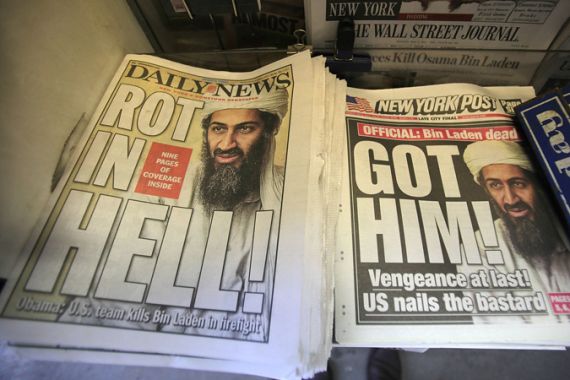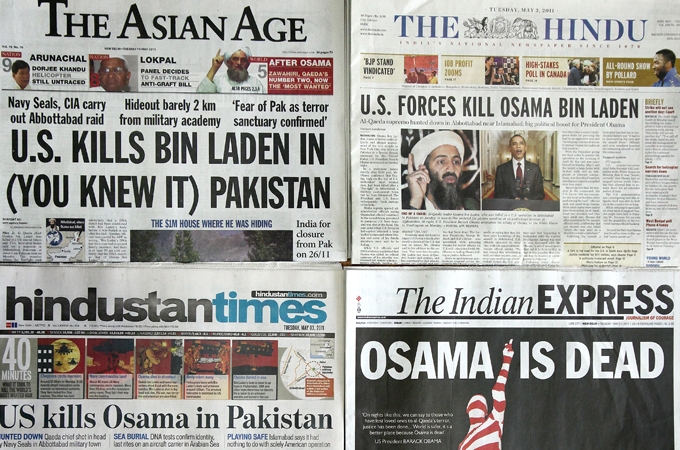Bin Laden’s death dominates front pages
Newspapers around the globe focus on al-Qaeda chief’s end and question why he remained undetected for so long

 |
|
One newspaper account said Obama requested time alone before okaying the mission in Abbottabad [EPA] |
Newspapers around the world all shared one story on Tuesday – the killing of Osama bin Laden. From details of the US-led operation to track him down, to questions over his burial at sea and reports that the fugitive shielded himself with his wife, all angles have been covered and scrutinised.
But the most compelling coverage has been of the story behind his tracking down, and how Barack Obama, the US president, watched the operation unfold.
“Obama saw Osama die on TV”, The Sun splashed on its website. Next to a picture showing the US leader watching a television screen intently, while Hillary Clinton, the US secretary of state, sits with her hand over her mouth, the paper said “Obama’s eyes were glued to a screen showing the dramatic moments leading to the death of bin Laden”.
“Obama could not hide his relief when he realised the deadly reign of bin Laden – codenamed Geronimo by US officials – was finally over,” it said.
The New York Times has given a detailed account on the “hunt for bin Laden”.
According to its report, Obama requested time alone before giving the greenlight for the mission in Abbottabad to go ahead.
There were long periods of silence, one aide told the paper. And then, finally, Mr Obama spoke: “I’m not going to tell you what my decision is now — I’m going to go back and think about it some more.” But he added: “I’m going to make a decision soon.”
“Sixteen hours later, he had made up his mind. Early the next morning, four top aides were summoned to the White House Diplomatic Room,” the New York Times reported.
“Before they could brief the president, he cut them off. “It’s a go,” he said. The earliest the operation could take place was Saturday, but officials cautioned that cloud cover in the area meant that Sunday was much more likely.”
‘Months of planning’
The Washington Post reported on the “months of planning” and the “minutes of execution”, from the US administration’s first break in 2005 when a senior al-Qaeda operative was turned over to the CIA and pointed interrogators to another messenger.
Although it took four years to track him down, the courier ultimately led to the compound where bin Laden was found, the paper said.
It said analysts then monitored the compound in Pakistan “so closely that they came to know its daily rhythms and the identities of its residents. Analysts concluded it was built to hide “someone of significance”, and that a third family was living on the floors above the courier and his brother”.
“It remains unclear when bin Laden first arrived, but officials said that the compound was under near-constant surveillance by the United States, and that it appears the al-Qaeda leader rarely – if ever – ventured outside,” the Post said.
Britain’s Guardian, however, has used the story to question why bin Laden was able to hide in Pakistan for so long, saying the Obama government was demanding answers.
“I think the Pakistani army and intelligence have a lot of questions to answer given the location, the length of time and the apparent fact that this facility was actually built for Bin Laden and its closeness to the central location of the Pakistani army,” Carl Levin, a Democrat who heads the powerful Senate armed services committee, was quoted in the paper as saying.
The Daily Mail took a similar line, questioning how the world’s most wanted man was living undetected in a “vast, custom-built compound only 800 yards from the country’s military academy”.
The Times of India’s looked at how coverage in Pakistan was also demanding answers from its government.
“Even in death, Osama haunts Pakistan,” screamed a headline in Pakistani media which said the US surgical strike deep inside the country was “something of an embarrassment” and added the “time for denial is over”.
The newspapers, which carried bin Laden’s death on front pages, highlighted the lack of clarity about Pakistan military’s role in the US raid, a day after the al-Qaeda chief was gunned down in a helicopter-borne operation 800 metres away from the Pakistan military academy near Abbottabad.
The London Times – including in its 23 pages of coverage of bin Laden the names of every single person killed by al-Qaeda – looked at further implications of the event.
Israel’s Haaretz stretched bin Laden’s death to its own peace process, declaring “Obama must bring his daring to Israeli-Palestinian peace”, but warned attacks were unlikely to end.
“The death of the spiritual leader of al-Qaeda terrorists won’t extinguish the zealotry surging through their murderous activities against Western targets, including Israeli and Jewish ones, in their attempt to impose Islam on the entire world,” the paper wrote.